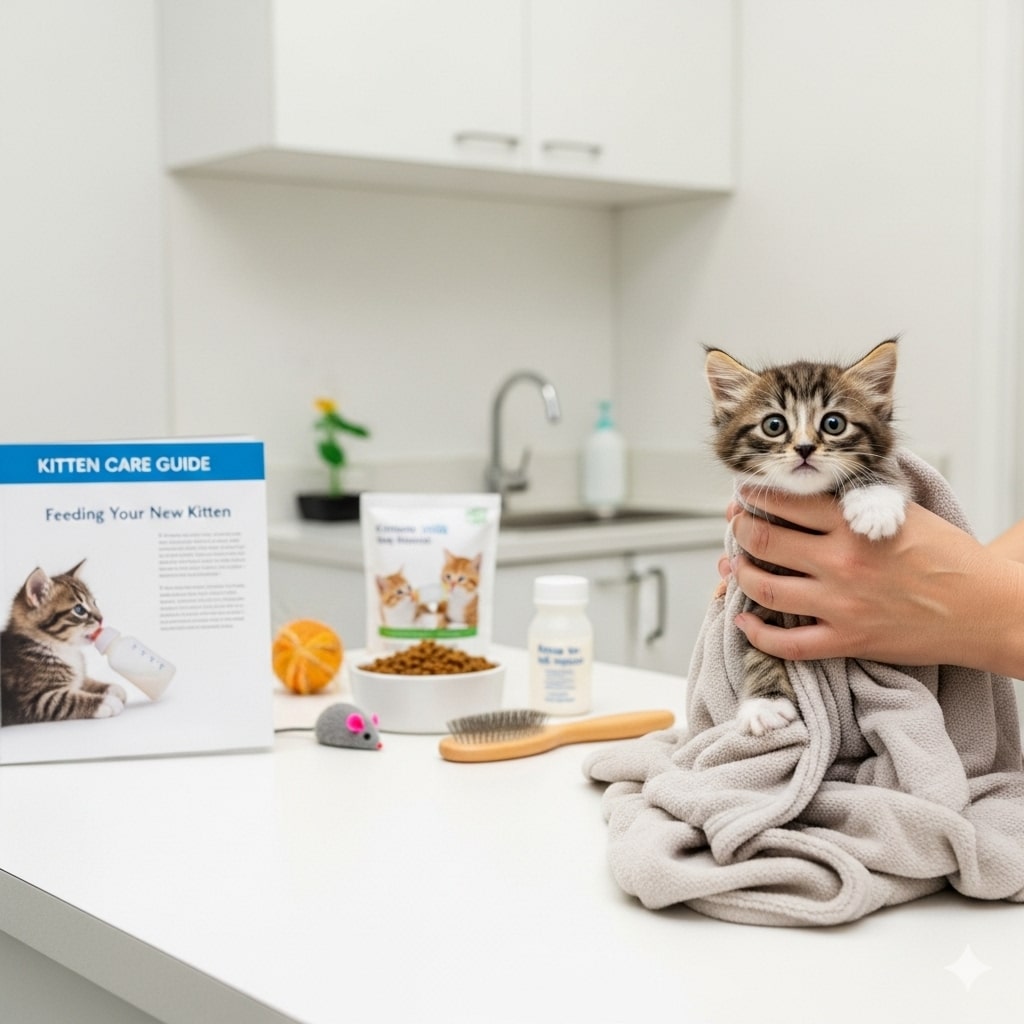Introduction
Bringing a kitten home is one of life’s most joyful experiences. The soft purrs, playful antics, tiny paws, and curious eyes instantly bring warmth and energy into your home. However, kittens are delicate beings that require special attention, care, and patience to thrive.
Taking care of a kitten is not just about feeding it and providing a litter box. It’s about understanding their physical, emotional, and social needs. Every kitten is unique, and providing the right environment, diet, grooming, and training ensures they grow into confident, healthy, and well-adjusted adult cats.
This complete descriptive guide is designed for both first-time cat owners and experienced pet parents. It will cover everything from setting up your home, feeding, grooming, health care, training, behavior understanding, and safety tips to ensure your kitten thrives in your care.
Discover More: Best Affordable Pet Insurance for Puppies in the USA 2025

Discover More: “Ultimate Cat Care Guide: Tips for Healthy, Happy Cats”
1. Preparing Your Home for a Kitten
Kittens are extremely curious and energetic. Before bringing them home, your environment must be safe, comfortable, and stimulating.
1.1 Kitten-Proofing Your Home
Kittens explore with their mouths and paws, often getting into things they shouldn’t. Kitten-proofing your home includes:
- Electrical cords: Use cord protectors or tape cords to walls. Kittens may chew cords out of curiosity or teething discomfort, which can be dangerous.
- Windows and balconies: Install secure screens or keep windows closed to prevent falls. Kittens are agile climbers and can slip easily.
- Small objects: Remove items like buttons, rubber bands, jewelry, and small toys that can be swallowed.
- Dangerous areas: Keep bathrooms, kitchens with cleaning chemicals, basements, and garages off-limits until the kitten is older and supervised.
- Houseplants: Some plants are toxic to cats (e.g., lilies, philodendrons). Keep them out of reach.
Tip: Observe your kitten during the first few days to identify any other potential hazards unique to your home.
1.2 Creating a Safe Space
A safe space gives your kitten a sense of security as they adjust to their new home. This space should be quiet, cozy, and comfortable.
Include:
- A soft bed or blanket in a draft-free area
- A litter box nearby but not too close to the feeding area
- Toys for mental stimulation, like small balls, feather wands, or interactive toys
- A scratching post or pad to prevent furniture damage
Descriptive Tip: Imagine a corner with a small cat tree, a soft bed, and toys neatly arranged. This becomes your kitten’s “safe haven,” a place where they can retreat, rest, and feel secure.
2. Feeding Your Kitten
Nutrition is one of the most important aspects of kitten care. A balanced diet supports growth, energy, immune function, and overall health.
2.1 Understanding Nutritional Needs
Kittens grow rapidly, so they need a diet high in protein, fat, and essential nutrients. Important nutrients include:
- Protein: For muscle and tissue development
- Fat: Provides energy and supports a healthy coat
- Calcium and phosphorus: Critical for strong bones and teeth
- DHA: Supports brain and vision development
- Vitamins and minerals: Maintain overall health and immunity
Descriptive Example: A 3-month-old kitten’s body is growing almost as fast as a human toddler. Missing essential nutrients during this phase can stunt growth or lead to long-term health issues.
2.2 Wet vs. Dry Food
- Wet food: High moisture content keeps kittens hydrated, soft texture makes it easy to chew, and it is usually more palatable.
- Dry food: Convenient, helps reduce plaque and tartar, suitable as kittens gradually transition to adult food.
Feeding Tip: Many owners combine wet and dry food to balance hydration, nutrition, and dental health.
2.3 Feeding Schedule
Kittens have small stomachs but high energy needs. Feed according to age:
| Age | Meals per Day | Portion Tips |
|---|---|---|
| 0–4 months | 4 | Small, frequent meals |
| 4–6 months | 3 | Slightly larger portions |
| 6+ months | 2 | Transition to adult feeding |
Practical Tip: Monitor your kitten’s weight and adjust portions to prevent obesity or malnutrition.
2.4 Foods to Avoid
- Chocolate (toxic)
- Onions, garlic, grapes, raisins
- Raw fish or meat (risk of parasites)
- Dairy (most kittens are lactose intolerant)
2.5 Hydration
Fresh water should always be available. Some kittens prefer running water; a small cat fountain encourages hydration.
3. Litter Training
Most kittens instinctively use a litter box, but training helps them learn quickly and consistently.
3.1 Choosing a Litter Box
- Shallow box for easy access
- Non-toxic, clumping litter
- Avoid strong-scented litters initially
3.2 Training Steps
- Introduce your kitten to the litter box immediately after bringing them home.
- Place them in the box after meals and naps.
- Praise or give a treat after successful use.
- Keep the litter clean by scooping daily and changing weekly.
Descriptive Tip: Observe your kitten’s body language—tail twitching or circling often indicates they need the litter box.
3.3 Common Issues
- Avoiding the litter box: May indicate stress, illness, or a dirty box.
- Spraying: Usually occurs in unneutered kittens; spaying/neutering resolves this.
4. Grooming Your Kitten
Grooming is essential for health, comfort, and bonding.
4.1 Brushing
- Short-haired: 1–2 times/week
- Long-haired: Daily
- Removes loose fur, prevents hairballs, and stimulates skin
Descriptive Tip: Brushing can be a bonding ritual. Use gentle strokes along the back, avoiding sensitive areas like the belly until the kitten is comfortable.
4.2 Bathing
- Only bathe when necessary
- Use kitten-safe shampoo
- Lukewarm water, gentle towel drying
Tip: Kittens often groom themselves, so avoid over-bathing.
4.3 Nail Trimming
- Every 1–2 weeks
- Avoid cutting the “quick”
- Reward kitten after trimming with treats
4.4 Dental Care
- Begin brushing early with kitten toothpaste
- Use small, soft-bristled toothbrushes
- Provide dental chews or toys
Descriptive Tip: Start with 30-second sessions and gradually increase time. Use praise and treats to create a positive association.
5. Health Care Essentials
5.1 Vaccinations
- FVRCP: Protects against Feline Viral Rhinotracheitis, Calicivirus, Panleukopenia
- Rabies: Required in many areas
- FeLV: Recommended for kittens at risk of exposure
5.2 Parasite Prevention
- Fleas and ticks: Topical or oral treatments
- Worms: Regular deworming as per vet instructions
5.3 Spaying/Neutering
- Recommended at 5–6 months
- Prevents unwanted litters and reduces risk of certain diseases
External Resource: AVMA Kitten Care
6. Socialization
Socialization shapes a kitten’s personality and confidence.
6.1 With Family
- Encourage gentle handling
- Avoid loud noises and sudden movements
- Supervise children
6.2 With Other Pets
- Introduce slowly, one at a time
- Scent exchange before face-to-face meeting
- Monitor interactions
6.3 Playtime and Bonding
- 15–30 minutes of daily interactive play
- Use toys instead of hands
- Encourages exercise, mental stimulation, and reduces behavioral problems
7. Training Your Kitten
Training develops good habits and prevents behavioral issues.
7.1 Basic Commands
- Use treats and positive reinforcement
- Teach commands like “come,” “sit,” and “stay” gradually
7.2 Correcting Behavior
- Redirect biting or scratching to toys
- Avoid punishment; kittens respond better to positive reinforcement
7.3 Scratching Behavior
- Provide scratching posts and pads
- Reward appropriate scratching
8. Mental and Physical Stimulation
Kittens are energetic and curious. Stimulation prevents boredom and destructive behavior.
- Toys: Wand toys, balls, and soft toys
- Puzzle feeders: Engage the mind and reward problem-solving
- Window perches: Provide safe outdoor views
- Supervised outdoor exploration: Use a harness
9. Understanding Kitten Behavior
9.1 Common Behaviors
- Kneading: Comfort and affection
- Purring: Contentment or seeking attention
- Hissing/growling: Stress or fear
9.2 Signs of Illness
- Lethargy
- Loss of appetite
- Excessive scratching or grooming
10. Traveling with Your Kitten
10.1 Car Travel
- Secure, comfortable carrier
- Avoid feeding right before travel
- Bring familiar toys or blankets
10.2 Air Travel
- Check airline policies
- Vaccination certificate required
- Spacious, ventilated carrier
11. Safety Tips
11.1 Indoor Safety
- Remove toxic plants
- Secure cords, blinds, chemicals, and medicines
11.2 Outdoor Safety
- Supervised exploration
- Microchip or ID tags
- Avoid exposure to aggressive animals
12. Milestones
- 0–4 weeks: Eyes and ears developing, dependent on mother
- 4–8 weeks: Weaning, socialization, play begins
- 2–6 months: Rapid growth, learning boundaries
- 6–12 months: Sexual maturity, behavior stabilizes
13. Senior Kitten Care (6+ Months)
- Gradually transition to adult food
- Maintain play and mental stimulation
- Monitor behavior and health
14. Common Health Issues
- Respiratory infections: sneezing, nasal discharge
- Gastrointestinal problems: diarrhea, vomiting
- Fleas, ticks, and worms
15. When to Visit the Vet
- Loss of appetite
- Vomiting or diarrhea >24 hours
- Difficulty breathing or coughing
- Unusual lethargy or behavior changes
16. FAQs
Q1: How long should kittens stay with their mother?
A1: Ideally 8–12 weeks for proper socialization and development.
Q2: Can I feed cow’s milk?
A2: No, most kittens are lactose intolerant; use kitten formula instead.
Q3: How often should I play?
A3: At least 15–30 minutes daily in short sessions.
Q4: When should I start grooming?
A4: As soon as you bring them home. Start with gentle brushing.
17. Kitten Care Checklist
| Task | Frequency |
|---|---|
| Feeding | 2–4 times/day |
| Litter box cleaning | Daily |
| Brushing | 1–7 times/week |
| Nail trimming | Every 1–2 weeks |
| Playtime | 15–30 minutes/day |
| Vet check-up | Every 3–6 months |
Conclusion
Raising a kitten requires love, patience, and consistent care. Proper nutrition, grooming, health check-ups, mental stimulation, and socialization form the foundation for a healthy, happy, and well-adjusted adult cat. With the guidance from this complete descriptive kitten care guide, you are fully equipped to provide the best start in life for your new furry family member.
Taking care of a kitten requires patience, love, and commitment. By following this comprehensive guide, you can ensure your kitten grows into a healthy, happy, and well-adjusted cat. Remember that early socialization, proper nutrition, routine veterinary care, and mental stimulation are the pillars of effective kitten care.
🐾 Note:
This article is for informational and educational purposes only. It should not be considered a substitute for professional veterinary advice, diagnosis, or treatment. Always consult a licensed veterinarian if you have any concerns about your kitten’s health, nutrition, or behavior.
